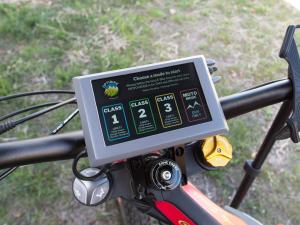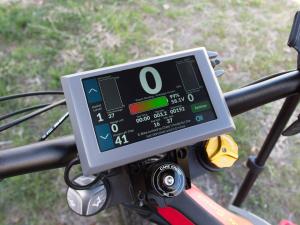New Patent Pending Display Gives Rider 4 E-Bikes in One
PAONIA, COLORADO, USA, April 18, 2024 /EINPresswire.com/ -- Title: Optibike Announces Revolutionary Multi Mode Display, Expanding Electric Bike Usage in the USA
Optibike, America's oldest E-Bike manufacturer, has just announced the release of its Patent Pending Multi Mode Interface (MMI). This groundbreaking technology is set to revolutionize the electric bike industry and dramatically expand the adoption of electric bike usage in the USA.
The new Multi Mode Interface (MMI) allows riders to select the class of E-Bike they need to conform to local laws, making it easier for riders to comply with regulations and enjoy the benefits of electric bikes. This innovative invention also opens up a wide range of possibilities for riders, allowing them to switch between modes and customize their riding experience.
According to Jim Turner, CEO of Optibike, "We are thrilled to introduce this game-changing technology to the market. Our Multi Mode Interface not only makes electric bikes more accessible and convenient for riders, but it also promotes the use of sustainable transportation and reduces carbon emissions. We believe this will have a significant impact on the future of transportation in the USA."
The release of the Multi Mode Interface (MMI) marks another milestone for Optibike, which has been at the forefront of the electric bike industry for over 20 years. With this new technology, Optibike continues to lead the way in innovation and sustainability, solidifying its position as a leader in the industry.
The Multi Mode Interface is now available for purchase on Optibike's Elite Series Electric Bikes. With this new technology, Optibike is confident that more people will embrace electric bikes as a viable mode of transportation, contributing to a greener and more sustainable future.
BACKGROUND OF INVENTION
Electric bicycle laws in the USA and other countries require Electric bicycles to be classified as Class 1, Class 2 or Class 3. These classifications affect the top speed and type of control of the E-Bike, either with a Throttle or Pedelec.
Bikes are programmed to one of these modes and are not changeable by the rider. This makes for limitations on the use of the E-Bike. As an example, many dedicated bike paths in cities require a Class 1 or 2 E-Bike that has a top speed of 20MPH. When on the bike lane on a road, a Class 3 bike is allowed with a top speed of 28 MPH.
A person commuting to a town and wanting to use the dedicated bike paths would need to use a Class 1 or Class 2 E-bike and have their speed limited to 20MPH. If they wanted to travel on bike lanes on roads to get to the town, they would still be limited to 20MPH, instead of 28 MPH, causing them to increase the time of their commute. The MMI allows them to change their classification and travel at 28MPH on the bike lanes along the roads.
Most bike trails require a Class 1 E-bike. If a rider wants to ride to the trail on their E-Bike, they would be limited to 20MPH on the streets with the Class 1.
In addition, E-Bikes can be ridden on OHV trials and roads and not be limited by the Class 1, 2, or 3 requirements of E-Bikes, and can have much higher top speeds and power. There are over 180,000 miles of OHV trials and roads in America today.
The current laws have made it so E-Bikes can not be optimized for every riding situation. This limits the use and adaption of E-Bikes to become more of an alternative to cars.
Example of Use:
Riding from the house to a E-MTB trail. The first 10 miles are on city streets and then 2 miles of dedicated bike paths. At the end of the E-MTB trail there is a fire road open to OHV motorcycles that is 3 miles until the road, which will lead back to the house.
Riding on the Bike Lane on City Street - Class 3
On most bike lanes on city streets, a Class 3 E-Bike is legal. (Pedelec, 28MPH, 750 Watts) After turning on the bike, the rider selects Class 3 on the MMI display. The bike is configured as the Class 3 E-bike. The time and distance in the Class 3 Mode is displayed. Rider travels 10 miles on the street to the dedicated bike path.
Riding on the Dedicated Bike Path - Class 2
Most dedicated bike paths in Cities allow Class 2 E-Bikes. (Pedelec, Throttle, 20MPH, 750 Watts) At the entrance to the bike path, the rider turns the bike off and then turns it back on and selects Class 2 on the MMI Display. The time and distance in the Class 2 Mode is displayed. Rider travels on the dedicated bike path to the E-MTB trail.
Riding the E-MTB Trail - Class 1
Most E-MTB trails require a Class 1 E-Bike. (Pedelec, 20MPH, 750 Watts) At the entrance to the trail, the rider turns the bike off and then turns it back on and selects Class 1 on the MMI Display. The time and distance in the Class 1 Mode is displayed. Rider travels the E-MTB trail to the OHV trail.
Riding the OHV Trail - Class 4 (Moto)
OHV trails allow motorcycles and there are no power or speed limits. There are over 180,000 miles of OHV trails in America.
At the entrance to the trail, the rider turns the bike off and then turns it back on and selects Class 4 (Moto) on the MMI Display. The time and distance in the Class 4 (Moto) Mode is displayed. Rider travels the OHV trail to the city street.
Riding on the Bike Lane on City Street - Class 3
At the end of the OHV trail, the rider turns the bike off and then turns it back on and selects Class 3 on the MMI Display. The time and distance in the Class 3 Mode is displayed. The rider uses the bike lane to return home.
James Turner
Opti-Bike LLC
+1 303-848-8385
email us here
Visit us on social media:
Facebook
YouTube



